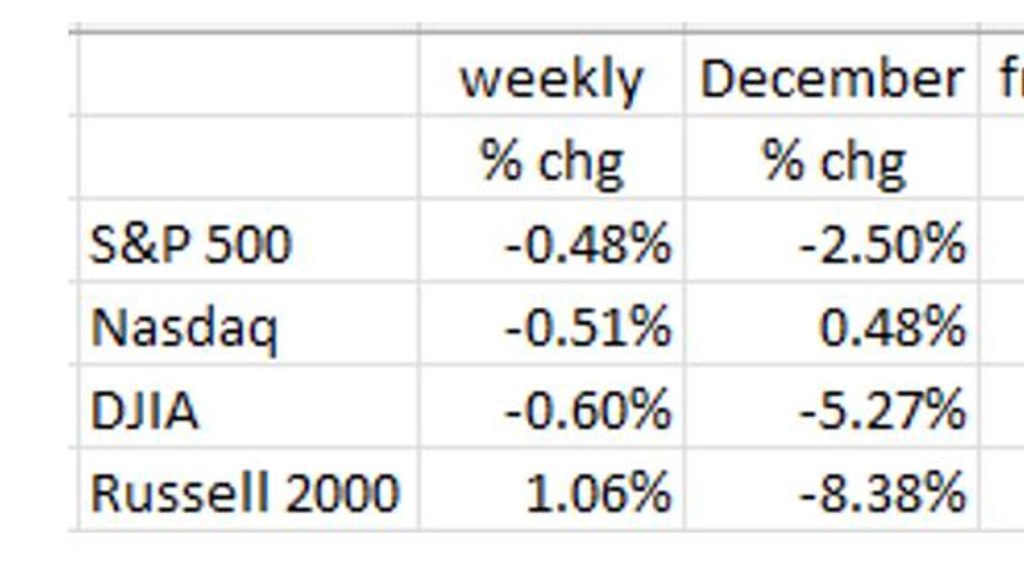Paragraph 1: Market Performance and Tech Dominance in 2024
The year 2024 witnessed robust performance in equity markets, with major indices recording double-digit gains. While the S&P 500 and the tech-heavy Nasdaq surged by over 20%, the Dow Jones Industrial Average (DJIA) and the Russell 2000 trailed with gains of 13% and 10% respectively. This disparity stemmed from the outsized influence of the "Magnificent Seven" tech giants, absent in the DJIA and minimally represented in the Russell 2000. These tech behemoths fueled the Nasdaq’s ascent, with their equal-weighted average return exceeding 60%. However, despite this exceptional performance, all seven stocks ended the year below their peak prices, although five reached new highs in December, with Nvidia and Microsoft peaking earlier in November and July, respectively. The market’s optimism carried into the new year, with six of the seven tech giants seeing price increases in the first two trading days of 2025.
Paragraph 2: Macroeconomic vs. Microeconomic Realities
A striking divergence emerged between the rosy macroeconomic picture painted by headline GDP growth and the underlying microeconomic data. While Q3 2024 GDP expanded by 3.1%, and Q4 forecasts hovered around 2.6% (according to the Atlanta Fed), microeconomic indicators suggested a less vibrant economy. Holiday spending, a key barometer of consumer activity, offered a contrasting narrative. Mastercard reported a nominal increase of 3.8%, which, after adjusting for the 2.7% inflation rate, translated to a meagre 1.1% real growth. This subdued consumer spending growth clashed with the robust GDP figures, signaling potential discrepancies in the overall economic assessment.
Paragraph 3: Microeconomic Indicators of Sluggishness
Further scrutiny of microeconomic data reinforced concerns about economic fragility. Industrial production remained stagnant, mirroring 2022 levels. Revised employment data revealed a decline of 725,000 jobs in the year ending November 2024, based on the Household Survey. The average duration of unemployment stretched to 24 weeks, a level last seen in May 2019, raising alarm bells reminiscent of pre-pandemic economic anxieties. The JOLTS report also indicated a contraction in job openings, retreating to pre-pandemic figures. This convergence of unfavorable employment indicators pointed towards a potential rise in the unemployment rate and further lengthening of unemployment duration.
Paragraph 4: Consumer Debt Distress and Rising Delinquencies
Adding to the economic unease, a surge in consumer debt delinquencies and defaults further underscored the microeconomic weakness. Credit card delinquencies witnessed a sharp uptick throughout 2023 and into 2024, while default rates, measured by write-offs, spiked significantly from their relatively low 2022 levels. Similarly, auto loan delinquencies climbed to post-pandemic highs, reflecting the increasing financial strain on consumers. These rising delinquencies and defaults painted a worrisome picture of consumer financial health, contradicting the seemingly strong macroeconomic narrative presented by GDP growth figures.
Paragraph 5: The Fed’s Hawkish Stance and Its Impact
Against this backdrop of conflicting economic signals, the Federal Reserve adopted a surprisingly hawkish stance, leading to a surge in interest rates. Market analysts, such as David Rosenberg, criticized the Fed’s contradictory policy of easing through rate cuts while simultaneously issuing hawkish guidance, creating confusion in the treasury market. This hawkish rhetoric, coupled with a minor uptick in inflation, drove bond yields higher. The 10-Year Treasury yield climbed from 3.6% in September to 4.6% by early January 2025, reflecting the market’s expectation of limited rate cuts in the coming year. This market sentiment contrasted with earlier projections of a sub-3% Fed Funds rate, highlighting the impact of the Fed’s surprising hawkish turn.
Paragraph 6: Inflation Outlook and Interest Rate Projections
Despite the Fed’s hawkishness, the authors maintain a more optimistic outlook on inflation and interest rates. They anticipate that the lagged effect of falling rents, which hold a significant 35% weight in the CPI, will push inflation below the Fed’s 2% target by the end of Q1 2025. This, coupled with a slowing economy, is expected to prompt the Fed to lower its target Fed Funds rate towards the "neutral" level of 3% or below by year-end. This projection diverges significantly from the market’s current expectation of rates hovering around 4%, suggesting a potential overestimation of future rate levels. The authors believe the Fed will be compelled to ease monetary policy as inflation subsides and economic weakness becomes more pronounced.










